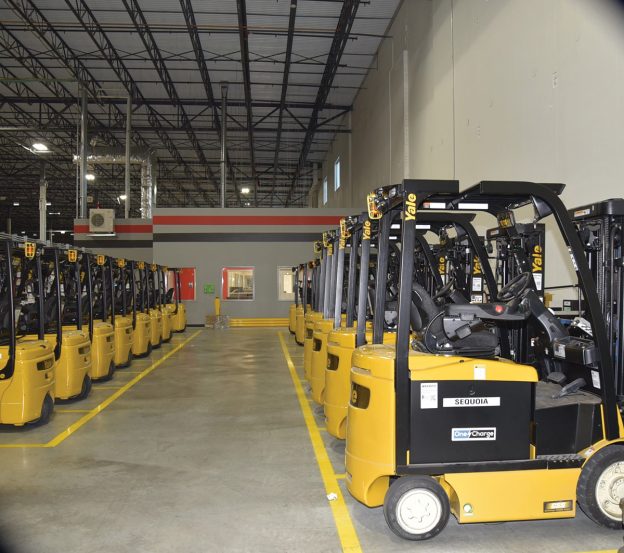In the fast-paced world of industrial logistics, forklifts which are also known as lift trucks are indispensable, and at the core of their operation lies the choice of battery technology. Traditionally, lead-acid batteries have dominated the scene, known for their reliability and affordability. However, lithium-ion batteries are gaining traction, offering improved performance and sustainability. In this blog, we’ll compare these two contenders, examining their strengths and weaknesses to help businesses make informed decisions about their material handling operations.
Join us as we dissect the heart of every forklift: its power source, and explore the evolving landscape of Lift truck batteries.
Navigating Lead-Acid Forklift Batteries: Reliability, Challenges, and Sustainability
Lead-acid batteries, renowned for their reliability and straightforward design, are a mainstay in forklift power systems. Comprising lead plates submerged in sulfuric acid electrolyte, produce electrical energy through a chemical reaction. While they offer cost-effectiveness and durability, lead-acid batteries have drawbacks, including lower energy density, necessitating frequent recharging and maintenance. Despite these limitations, their high recyclability presents a sustainable solution to environmental concerns. Businesses must carefully consider these factors to optimize forklift operations while minimizing environmental impact.
In summary, lead-acid batteries remain a prevalent choice for forklift power due to their reliability and affordability. However, businesses must weigh their advantages and drawbacks to ensure efficient operations and environmentally responsible practices.
Exploring Lithium Power: Insights into Forklift Battery Technology
Lithium-ion batteries stand as a promising alternative to traditional lead-acid counterparts in the realm of forklift power. With their high energy density and lightweight design, lithium-ion batteries prove well-suited for the demands of forklift operations. Comparatively, they offer distinct advantages over lead-acid batteries, including longer lifespan, faster charging capabilities, and reduced maintenance requirements. However, it’s essential to consider potential drawbacks such as higher initial costs and sensitivity to temperature fluctuations. Despite these challenges, ongoing technological advancements continue to enhance the efficiency and reliability of lithium forklift batteries.
Innovations like smart battery management systems and rapid charging technologies contribute to their appeal in industrial settings. Moreover, while lift truck batteries may entail higher upfront investments, their long-term savings potential through extended lifespan and decreased maintenance expenses should not be overlooked. By comprehensively analyzing the capabilities and economic implications of lithium-ion batteries, businesses can make informed decisions to optimize their forklift operations.
Comparison of Lithium vs. Lead-Acid Forklift Batteries: Key Differences
| Comparison Factor | Lithium-ion Batteries | Lead-Acid Batteries |
| Energy Density | Higher energy density, allowing for longer runtimes and increased efficiency. | Lower energy density, leading to shorter runtimes and reduced efficiency. |
| Charging Time | Accelerated Charging: Reducing Downtime and Boosting Productivity | Slower charging times, potentially leading to increased downtime. |
| Lifespan | Longer operational lifespan, resulting in fewer replacements and lower lifecycle costs. | Shorter operational lifespan, necessitating more frequent replacements and higher lifecycle costs. |
| Efficiency | More efficient energy conversion and utilization, delivering more power to the forklift’s motor. | Less efficient energy conversion and utilization, resulting in lower power output. |
| Maintenance Requirements | Minimal maintenance requirements, reducing operational overhead | Regular maintenance is required, including watering, equalization charging, and terminal cleaning |
| Temperature Sensitivity | More sensitive to extreme temperatures, may experience reduced performance and lifespan in harsh environmental conditions | Better tolerance to extreme temperatures, capable of operating effectively in a wide range of environments |
This comparison chart highlights the key differences between lithium and lead-acid forklift batteries, providing businesses with valuable insights to make informed decisions regarding battery selection for their material handling operations.
Environmental and Sustainability Comparison: Lithium vs. Lead-Acid Forklift Batteries
| Environmental and Sustainability Factors | Lithium-ion Batteries | Lead-Acid Batteries |
| Carbon Footprint | Typically lower due to longer lifespan and higher energy efficiency. | Relatively higher due to shorter lifespan and lower energy efficiency. |
| Recyclability | Moderate recyclability, but challenges exist due to complex composition. | Highly recyclable, with up to 99% of materials capable of being reused. |
| Disposal Methods | May pose challenges in recycling and disposal due to toxic materials and complex composition. | Relatively straightforward recycling process with established infrastructure. |
| Environmental Impacts | Lower environmental impact during the usage phase, but challenges in manufacturing and recycling. | Higher environmental impact during the usage phase, but efficient recycling mitigates long-term environmental impact. |
| Regulatory Compliance | Subject to evolving regulations regarding battery production, usage, and disposal. | Compliance with established regulations for battery production, usage, and disposal. |
This comparison chart highlights the key differences between lithium and lead-acid forklift batteries in terms of their environmental and sustainability factors. It equips businesses with invaluable considerations for assessing the ecological footprint and long-term sustainability impacts of their battery technology decisions.
Conclusion: Optimizing Lift Truck Batteries Selection for Sustainability
In this blog, we’ve compared lithium and lead-acid forklift batteries, discussing their composition, advantages, and environmental impacts. It’s crucial to assess operational needs when choosing between the two. While lithium-ion batteries offer longer lifespan and faster charging, lead-acid batteries are affordable and highly recyclable. Future innovations in recycling methods and alternative chemistries hold promise for greener operations. Businesses should consider performance, cost, and environmental factors to optimize operations and contribute to sustainability.




